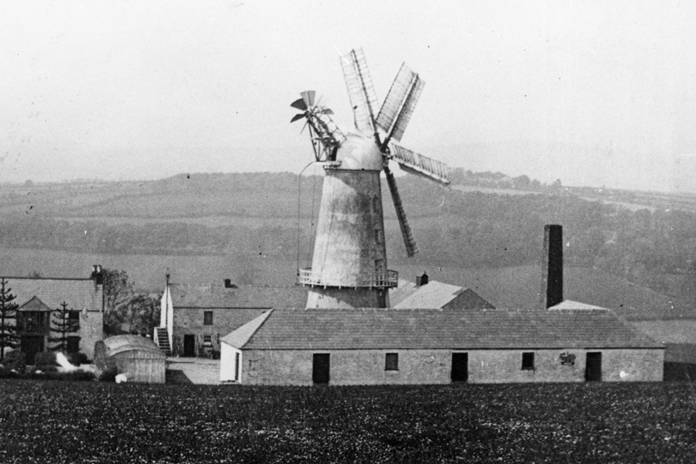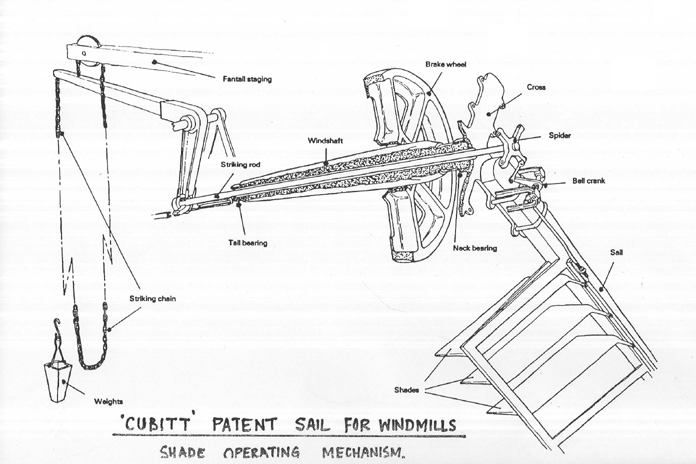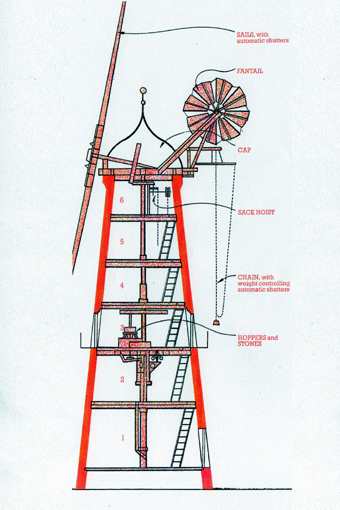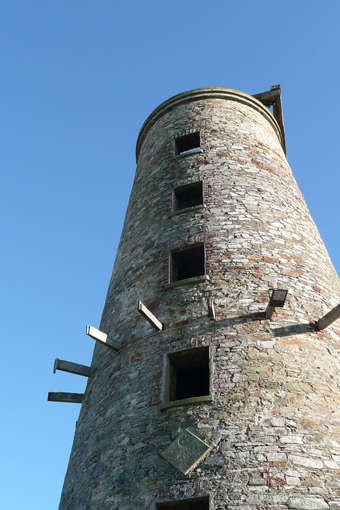Building of the Month - March 2017


A gently tapering tower surviving from the windmill built in 1874 for Charles Robinson (d. 1906). The windmill continued to be worked by the Snodgrass family until circa 1932. The sails of the windmill were damaged or destroyed on at least three occasions over the course of its working life and were finally blown away during a storm in the 1960s
Standing close to the summit of Croaghan Hill, near Murlough, County Donegal, are the remains of possibly the most advanced windmill in Ireland. Windmills were rare in County Donegal where water was the primary source of power for the many corn and flax mills operating in the nineteenth century. The windmill was built in 1874 for Charles Robinson (d. 1906), farmer, who was the leaseholder of a farmstead and 118 acres of arable land owned by the Earl of Erne. Originally called Fir Grove, the property has since taken on the name of its most significant architectural feature and is now known as Windmill Farm.
.jpg)
John Sanderson (1819-1901), engineer and millwright, photographed in old age circa 1893 |
While researching the history of John Sanderson (1819-1901) of Louth, Lincolnshire, one of England’s premier engineers and millwrights, I came across an intriguing reference to his firm having fitted out two windmills in Ireland. This was left by an employee millwright, James Emerson, who had worked for Sanderson in the 1870s. He listed the various mills he had worked on which included ‘the interior fittings for two four sail mills erected by Mr. Sanderson in Ireland’. Most of the firm’s records were deliberately destroyed once the business was declared bankrupt in 1912, its centennial year, and this left much subsequent research to be conducted through secondary sources. Early clues as to the identity of one of the Irish Sanderson mills were discovered through newspaper articles available in The British Newspaper Archive. Advertisements published in the Derry Journal in December 1878, when Robinson put the Fir Grove premises up for sale on his retirement from farming, stated that Ballindrait Mill was erected by one of the best mechanics in England. Sanderson was rightly renowned for his advanced and well-designed windmills. The firm is known to have fitted out many four-sail mills; at least seven six-sail mills; three five-sail mills; and one eight-sail mill with the latter, erected at Much Hadham in Hertfordshire, having the distinction of being the last windmill to be built in England. Two of the Sanderson six-sail towers survive at Sibsey (1877) and Waltham (1879-80), Lincolnshire. |
A later article published in 1898 by The Pictorial Record and Illustrated Advertiser describes the Louth premises and Sanderson’s products and also states that ‘Mr. Sanderson junior [is] in Ireland superintending some repairs to the machinery of a scutching mill at Donegal that the firm had put in a quarter of a century ago’.

An early twentieth-century photograph showing the working windmill and its associated outbuildings including an engine house with tapering chimney
Further enquiries led me to the National Inventory of Architectural Heritage who recorded the remains of Ballindrait Mill as part of the survey of the architectural heritage of County Donegal. The NIAH were able to provide an old photograph of the mill in its working days and a number of features only visible in the photograph enabled me to compare it with the Sibsey and Waltham mills and confirm that it was a Sanderson mill.
.jpg) |
.jpg) |
Sanderson’s firm is known to have fitted out many four-sail mills; at least seven six-sail mills; three five-sail mills; and one eight-sail mill. Two of the Sanderson six-sail mills survive at Sibsey (left) and Waltham (right) in Lincolnshire
The two surviving mills show a ball finial-topped white domed cap and eight-bladed fan, both visible in the old photograph of Ballindrait, while Sibsey Mill features similar double-sided sails mounted on a cast-iron cross secured to an iron axle or wind shaft. The sails, a self-regulating system invented in 1807 by (Sir) William Cubitt (1785-1861) of Norfolk, were standard equipment on all Sanderson-built windmills. An elaborate wrought iron balcony at Sibsey, allowing the setting of the sails at the start of the working day and the application of the brake in the evening, is shown in a simpler timber guise in Ballindrait. Only the cantilevered timber work of the walkway survives today.

Three pairs of mill stones are believed to survive in situ on the third floor at Ballindrait. These would have been driven by the rotating sails through gearing and shafting cumulating in a cast-iron horizontal great spur wheel turning timber toothed pinions. This system is similar to that seen at Sibsey. In addition to wind power, steam power generated from the engine house – visible on the right of the old photograph with its tapering chimney – would have been transmitted into the ground floor of the tower using a combination of shafting and belts and pulleys. Waltham Mill, built at the end of the wind power era, was, like Ballindrait, designed to be worked by both steam and wind.
 |
A section diagram of Sibsey Mill (left) and a photograph of the stone floor (right) including the great spur wheel |
The Derry Journal provides much information on the now-lost equipment in Ballindrait Mill and the uses put to the outbuildings in the courtyard surrounding the tower. It states that the mill was ‘working three pairs of French burr stones… [The windmill can develop] up to 40hp and can be wrought with either steam or wind or with both. It is 60 feet high with seven floors; the engine made by Tennant & Company [of Edinburgh] is horizontal of 10hp and the Cornish boiler is first class, 20 feet long, and 5 feet in diameter with a 3 foot flue’. The outbuildings surrounding the tower included a corn kiln, ‘quite new [and] about 18 feet [high] having a green loft attached’. A flax mill of two storeys had recently been erected containing eight stocks with patent rollers and could be driven, as the mill, with steam or wind. ‘A splendid thrashing machine with patent slakers and also a good pulp and hay cutter driven by either steam or wind or both’ completed the outbuildings. The newspaper also noted that the farmhouse and outbuildings, including the mill, could be lit with gas produced on the premises.
As an aside, an amusing anecdote is included in a report in the Derry Journal (6th September 1878) on the annual show of the Earl of Erne’s Donegal estates around Ballindrait and Lifford. The Earl, addressing his tenants, stated ‘the previous year when I came, I paid a visit to Mr. Robinson who received me very well. Great people generally are received with a salute of twenty-one guns, but instead of firing a salute of guns in my honour he did the next best thing and set his windmill in motion – (laughter) – which startled my horse and upset the trap throwing me out’.
|
Following its sale by Robinson the mill is recorded to have been worked by the Snodgrass family until circa 1932. Over the course of its working life the sails of the windmill were damaged or destroyed on at least three occasions and a Snodgrass descendent maintains that the mill would have been better built in a valley as its lofty exposed site was susceptible to the full force of Atlantic gales. Local information records that the cap and sail remains were finally blown off during a storm in the 1960s and all of the machinery, besides the mill stones, was removed thereafter. A group of local enthusiasts attempted to raise interest in the restoration of the mill in the 1970s, but without success. Today the gently tapering stone tower of the mill survives as a monument of the nineteenth-century industrial heritage of County Donegal and the whole of Ireland. The seven-storey tower of coursed rubble fieldstone, originally lime rendered, features a rusticated panel at its midway point perpetuating the memory of its builder Charles Robinson. The panel also features a masonic symbol and the date of construction. The windows on each floor are missing their fittings and, open to the elements, the timber work within the tower is at risk of collapsing if conservation and stabilisation of the fabric is not undertaken in the near future. |
 |
.jpg)
A rusticated date stone features the name of the builder together with a masonic symbol and the date of construction
The identity of the second windmill fitted out by Sanderson in Ireland has not yet been proven. A six-storey tower at Ballougry, County Derry, erected in 1874 for Joseph MacPherson (d. 1892), has a number of features that make it a strong contender. The tower retains no machinery and as yet no photographs of it in its working life have come to light and so my research continues…
Jon Sass, Chairman of the Lincolnshire Mill Group, has been involved with the repair, operation and recording of traditional mills since leading the restoration of the last Lincolnshire post windmill in the 1960s. He has written several books including The Versatile Millstone (1984) describing the manufacture and the many industries millstones once served, The Windmills of Lincolnshire (2012), and a paper on the Sanderson family of millwrights in England is about to be published. Jon lives in Lincolnshire, England, and is married with three adult children
Back to Building of the Month Archive